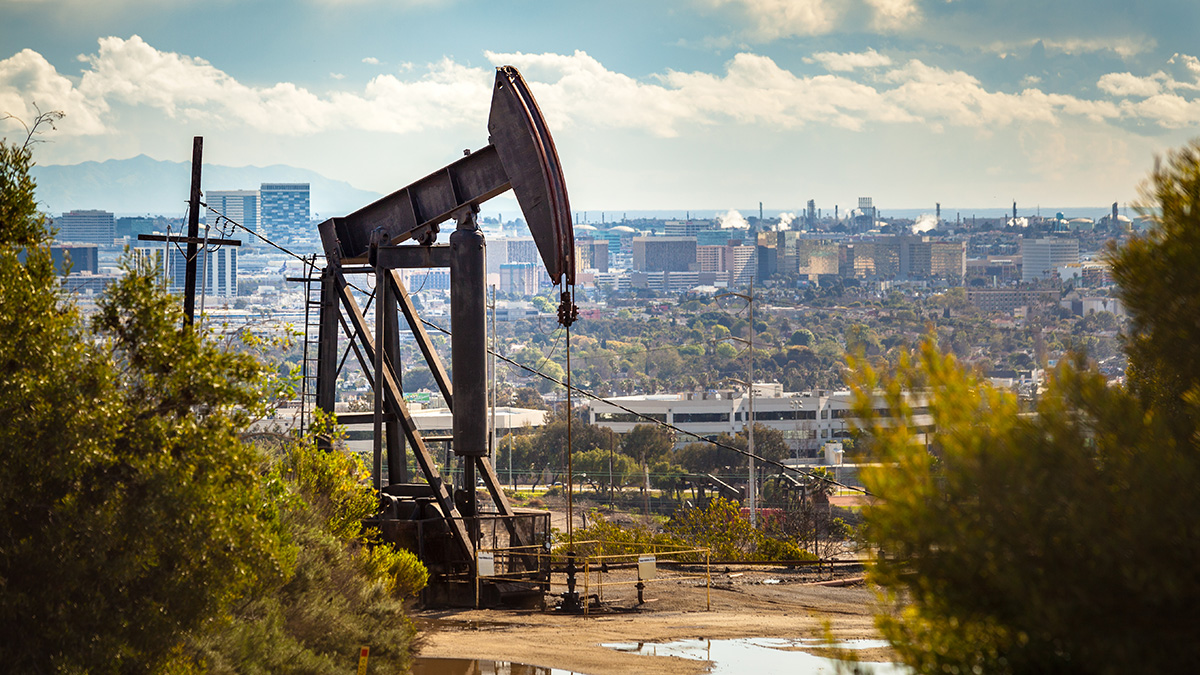In the late 19th century, prospectors discovered oil flowing under the burgeoning city of Los Angeles, and thousands of sites were soon developed to extract the thick, sticky substance that came to be known as “black gold.” Many functioning pumpjacks and oil derricks remain today, sometimes cleverly camouflaged and often in proximity to people’s homes and places of work. But public sentiment about fossil fuels is shifting in the face of climate change, and recent legislation enacted in Southern California is calling into question the future of oil pumping in the City of Angels.
The Riches Under La-La Land
“Cubic kilometer for cubic kilometer, we have the highest concentration of oil.”
The world’s richest oil field isn’t located in the Middle East or Russia—it’s in Los Angeles. That often comes as a surprise to people, but it’s true, said Dan Tormey, a geologist and president of Catalyst Environmental Solutions, an environmental consulting firm based in Santa Monica, Calif. “Cubic kilometer for cubic kilometer, we have the highest concentration of oil.”
Thousands of oil wells dot the Los Angeles basin to extract all that oil. Many of them are serviced by infrastructure that’s clearly visible, although some of the machinery is seamlessly tucked into the fabric of the nation’s second-largest city. “A lot of these oil operations are hiding in plain sight,” said Jill Johnston, an environmental health scientist at the University of Southern California in Los Angeles. “People don’t necessarily realize what’s happening on the other side of a fence or hedge in their neighborhood.”
Tormey has gotten to know many of Los Angeles’s oil fields in the course of guiding clients around the city. (He’s developed an 11-stop tour highlighting different drilling sites and an accompanying guidebook he hopes to have published.) And at the Geological Society of America Connects 2022 meeting held in October in Denver, Tormey discussed the geoheritage of oil extraction in Los Angeles.
The first commercial oil drilling operations in Southern California began in the 19th century, Tormey recounted, but Indigenous Peoples in the area had long since recognized the utility of the sticky black substance that oozed from the ground. “The Chumash, the Indigenous People who lived in this area, used to mine oil seeps to seal water containers and boats,” said Tormey.
By the early 1900s, thousands of oil wells were busy extracting California’s black gold. Once-pristine landscapes became dominated by oil derricks and pumpjacks. But by the 1960s, as land prices rose and industries like filming and aerospace proliferated in Los Angeles, drilling became more consolidated, with less aboveground infrastructure taking up valuable real estate. The “oil islands” that persist today in Los Angeles are small—often under an acre—but their underground reach can be vast, said Tormey. “They access large parts of the oil field that previously had a distribution of individual wells.”
Cleverly Camouflaged
Some of the aboveground infrastructure that remains, particularly in more affluent areas, is camouflaged. Cardiff Tower, erected in a largely Jewish neighborhood, mimics the architecture of a synagogue. The beige building with graceful white arches, built in 1966, hides 40 wells.
Other sites are no longer operational, but their creative facades endure. On a busy thoroughfare near the Los Angeles County Museum of Art, a nondescript (albeit windowless) office building perches on a street corner across the street from a flooring store. Hidden within the seven-story beige structure is an oil derrick that once serviced more than 50 wells.
The End of an Era?
But the heyday of Southern California oil seems to be waning. Production is significantly down from just a few decades ago, and environmental justice groups such as Stand Together Against Neighborhood Drilling (STAND-L.A.) have been vocal about phasing out drilling in residential areas. In 2017, a group of health care professionals wrote a letter to the Los Angeles City Council urging that a 2,500-foot (762-meter) buffer zone be erected around urban oil and gas extraction facilities. The group cited research showing that these facilities emit carcinogens that have been linked to an increased risk of lung cancer and leukemia. A recent study also demonstrated that people living close to active oil sites have poorer respiratory health and reported a higher incidence of eye and nose irritation.
And change is underfoot. Last year, the County of Los Angeles Board of Supervisors unanimously voted to limit oil drilling in unincorporated parts of Los Angeles. The ruling bans new oil wells and designates current facilities as “nonconforming,” meaning that the drilling permits they currently hold could potentially be revoked. Earlier this year, the City of Los Angeles also passed a similar referendum. These changes represent progress when it comes to the health of Angelenos, said the University of Southern California’s Johnston. “It’s really critical when we think about land use and public health and environmental justice.”
There very well might come a day when oil is no longer pumped from the underbelly of Los Angeles. But California’s future as an energy-producing powerhouse is secure—the state is rich in wind and solar power, both renewable resources whose reach will only grow with time: Next month, the Bureau of Ocean Energy Management will hold an offshore wind energy lease sale for roughly 370,000 acres located off the coasts of central and Northern California.
—Katherine Kornei (@KatherineKornei), Science Writer
This news article is included in our ENGAGE resource for educators seeking science news for their classroom lessons. Browse all ENGAGE articles, and share with your fellow educators how you integrated the article into an activity in the comments section below.


